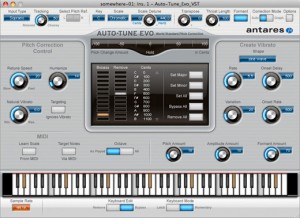"Insert Scene" by Erin Barra: Confessions of an Auto-Tune Aficionado
Bitch, Correction!
Man, I love Auto-Tune… I really really do. Not only do I “Believe” In Life After Love, but I also “Party in the USA” and frequently “Blame it on the Alcohol”… especially before or after a “Sexual Seduction.” (badum pa!!)
Pitch correction, and specifically the Antares plugin has woven itself into the fabric of mainstream music, gotten invited to every session in nearly every studio worldwide, and is referred to, by name, by millions of people who don’t even know what a digital plugin is.
Everyone from Rodney “Darkchild” Jerkins to your little sister have their own ideas about what they think Auto-Tune is and why they either love it or hate it.
I don’t love Auto-Tune because I’m a terrible singer… although I will say it has SAVED MY ASS on several occasions; I love Auto-Tune because it is an extremely useful weapon in any engineer’s digital arsenal and is about as versatile as a Swiss Army Knife.
In my mind, a lot of people need to be put in their place for not only poorly using the technology, but also for talking about it like some skank that stole their boyfriend.
Auto-Tune is not the enemy… we are.
WHA?
At its very core, Auto-Tune is an audio processor which adjusts pitch according to set parameters. i.e. scale, range, speed etc… It was created in 1997 by a company named Antares and was somewhat “stumbled upon” by an Exxon engineer named Andy Hildebrand who was actually developing methods for interpreting seismic activity.
According to a sanctioned Antares tutorial, their plugin is, “Used in order to save studio and editing time, ease the frustration of endless retakes, save that otherwise once in a lifetime performance, or even to create unique special effects”.
I think this is an apt yet very vague description of its function. Here are a couple other specific examples I would add:
— Used to act as a supportive foundation for any vocalist in a session
— to sometimes give an artist a false sense of vocal ability
— to make up for a complete lack of vocal ability
— to smooth the rough pitch edges of any audio file
— to achieve a very specific “digitized” and mainstream sound
— to take otherwise normal snippets of audio and make them hilarious.
I work with a lot of different types of artists in a lot of different capacities, and whether or not they know it, I use the Antares plugin on pretty much every single one of them.
It’s completely commonplace for an engineer to run a vocal through the plugin while the artist is tracking in the booth, granted with some very subtle and specific settings. What that means is that the vocal they’re hearing in their headphones, as they sing it, has already been Auto-Tuned. (dun dun dun!)
Whether it’s a stylistic choice, a time-saver, or a way to “turn down the suck knob” on an artist, Auto-Tune is ubiquitous and is on almost every album currently made. End of story. Get over it.
It gives you an appreciation and perspective on how much time and effort went into creating music before these types of technologies we’re easily accessible… before the days of cutting corners and immediate return.
Go listen to Fiona Apple’s album Tidal… she’s frequently off-pitch and yet it’s one of the most beautiful albums I’ve ever heard. People hardly ever make music like that anymore : /
You Give Auto-Tune a Bad Name
Is it sad that most of the songs on the radio have that “pitch perfect” monotony to it? Yes!
Does it totally grind my gears that artists completely devoid of talent have replaced timeless and meaningful music? Yes!!
Do I shudder every time I hear a new Lil’ Wayne track that sounds EXACTLY like all the other ones? YES!!!!
Do I secretly wish that a certain group of artists and producers would conveniently die in the same structure fire? …. Yes.
Do I think things would be better had Auto-Tune never hit the market? NO!!!!
A metaphor, if I may: Auto-Tune is the car you drive between your house and the Wendy’s down the street that you’ve become too lazy to walk to. Arguably, you could debate that cars have made people fat and lazy. But most everybody’s got the right to drive a car even though most of them shouldn’t. Do you blame the car, the driver or the advent of the vehicle? I blame the driver.
Pitch correction didn’t ruin the music; the music business ruined the music. If anything, blame the producers or the people behind the computers (although most of them are just sheep simply doing what they have to).
That being said, there ARE a lot of people out there who use Auto-Tune in creative, inventive, and — not to mention — highly functional ways. If Auto-Tuning your audio files is going to help you achieve the larger purpose of supporting your overall art form, then by all means, plug it in.
Since this is my blog, I’ll take the opportunity to toot my own horn and give what I like to think is a worthy example. I have a song on my record Illusions entitled “Magician,” and in the live version of the song I use the Anteras EFX plugin on my vocal. Since the song is about a Magician I decided to perform a little sonic magic of my own.
And, might I add, lots of people give me crap for doing it, saying things like, “ you don’t have to hide behind the Auto-Tune,” when really they don’t even take into consideration why I used it in the first place.
(Check it out right here — I activate the plug in about 1:30 into the clip.)
Antares, the Fabric of our Lives
At this stage in the game, pitch correction is so diffused that it’s become nuanced. Nobody does it exactly the same and every producer’s approach has a distinct flavor to it. For instance T-Pain and Drake both have signature Auto-Tune settings, which are widely Googled and easy to find (duplicating them isn’t as straightforward as looking them up, thank God).
There IS such a thing as “good” Auto-Tune and then there’s “good’s” more common and irritating sibling, “bad.” Bad Auto-Tune is being broadcast somewhere in the world at all times and is almost impossible to avoid.
I am currently working with a young R&B artist who was born in 1993. The first few times we were tracking vocals I was listening to him, wondering why his notes were literally being pulled apart and nudged before I had even inserted the plugin.
After a few moments of not being able to figure it out, it dawned on me: His ears are so accustomed to pitch correction being a part of the sounds he hears that he had actually trained his voice to duplicate the sound. Having grown up when he did, the Auto-Tune effect had somehow become innately in his ears and throat.
When we purposefully throw a heavy Auto-Tune on certain phrases in his tracks, it sounds CRAZY. Try duplicating that, T-Pain!!!
Learning to Let Go
I hope that at this point in the discussion that we can all agree that Auto-Tune is just a part of life, and it’s likely not going anywhere. And although I truly appreciate a pair of discriminating ears, I feel it’s time to let go of our discriminating ways.
Instead of fighting against Auto-Tunes’ already blanketed colonization, let’s try to see the positives in each other and see if we perhaps can evolve together, without ever forgetting what came before.
BTW, here’s a few helpful tips on how to operate the Antares product from VS Planet http://www.vsplanet.com/ubbthreads/ubbthreads.php?ubb=showflat&Number=526579
ERIN BARRA: Singer/Songwriter/Producer/Multi-Instrumenatlist/Ableton-Enthusiast/Nationally-Touring-Aritst. Also visit her on Facebook or Twitter @erinbarra.









Guest
January 17, 2012 at 7:36 pm (13 years ago)Why does everyone believe Lil Wayne only utilizes autotune when making a song. His first album with a group came out in 1997, and his first solo album came out in 1999. Lollipop, his biggest hit involving the use of autotune, came out in 2008. So that means that there are nine years worth of songs that do not involve that particular device. His best and most introspective songs, such as Hey America, Amen, Something You Forgot, Trouble, etc, have no autotune whatsoever.
Dave Kowalski
January 19, 2012 at 8:44 pm (13 years ago)Here’s my take on the subject:
.Autotune Turned Me Into A Star – YouTube
David Kowalski
http://www.davidkowalski.com
Dave
January 19, 2012 at 8:45 pm (13 years ago)I mean this, sorry:
http://www.youtube.com/watch?v=zCe67h3xXQo
Guest
January 19, 2012 at 9:01 pm (13 years ago)It’s the emblem of a new era. When I came up, we hired talent. People had to be able to sing. Once in a while, they’d have a great take, with one or two bad notes. We punched them in. If you only had one track open for the vocal, decisions had to be made as to whether the singer was capable of doing it better, or if this was a keeper. As track counts grew, there was more flexibility, but still, the singer had to perform. That’s how records were made then, and how some people still choose to make them.
With today’s technology and musical tastes, there are other options. Auto-tune is to singers what quantizing is to programmers, looping and pasting to arrangers, etc. Music recording/mixing technology is available at a lower price, and so recording your own music can be enjoyed by thousands of people who would not have been able to get record deals or otherwise afford studio time under the old system. As I said, it’s a different world. No judgments, not better or worse, just different.
One advantage that auto-tuning has in this world that you didn’t mention is that when one is singing against synths and midi tracks that are rigidly tuned, any deviation from exact pitch is much more noticeable. Acoustic instruments all have anomalies in their tuning. A piano sounds best with a stretch tuning – slightly flat on the low notes, slightly sharp in the higher octaves, giving more pleasing harmonic content. Guitars are often slightly out of tune over the length of the neck, and fretless instruments like violins and upright basses rely on interpretation of proper pitch. For many instrumentalists, a Bb in one scale is different from an A# in another scale. When a band is composed of several instruments with these pitch vagaries, there is more room for slight deviations. For most listeners, our ears accommodate some degree of differences in pitch. Most singers feel they have a wider comfort zone for pitch discrepancies when singing to acoustic/electric instruments.
Midi instruments do not treat pitch in this manner. They are rigid. An A# is the same as a Bb. Try playing a nylon string guitar against a midi track. You will most likely hear pitch problems that would be masked in any other setting, no matter how many times you stop and re-tune. For vocalists, midi tracks can be extremely unforgiving. Auto-tune, when used right, can allow them to sound human without sounding pitchy.
Personally, I try to use Auto-Tune very little, or as a last resort in mixing acoustic/electric pieces, but consider it a welcome and necessary part of mixing a piece of electronic/midi-based music.
Dave
January 20, 2012 at 1:40 pm (13 years ago)Yes, I agree, it is just a tool, and a very good one (Melodyne is my choice for tuning). You can use a hammer to build something or smash it to pieces!
Dave Kowalski
http://www.youtube.com/watch?v=zCe67h3xXQo
Darko Saric
January 20, 2012 at 5:42 pm (13 years ago)Why they called Auto-tune? Why not Audio-mangle? Because they were selling the idea that now everybody can sing and record an album.